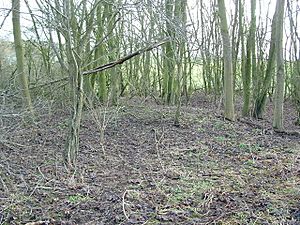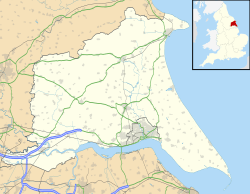Danes Graves facts for kids

A shallow barrow at Danes Graves
|
|
| Location | near Kilham, East Riding of Yorkshire |
|---|---|
| Region | Yorkshire |
| Coordinates | 54°03′20″N 0°26′47″W / 54.055610°N 0.44638196°W |
| Type | Iron Age Cemetery |
| History | |
| Cultures | Arras Culture |
| Site notes | |
| Public access | In dense woodland |
Danes Graves is an ancient burial site in the East Riding of Yorkshire, England. It's part of the Arras Culture, a group of people who lived during the British Iron Age. They were known for burying people, and sometimes even chariots, in their graves.
This old cemetery is in a dry valley called Danesdale. The ground there has gravel and chalk. You can find Danes Graves near the village of Kilham, which is north of Driffield.
Discovering Danes Graves
People first started looking into Danes Graves a long time ago. The earliest recorded digging happened in 1721. At that time, several burial mounds (called barrows) were explored. Sadly, no records of what they found still exist today.
More excavations took place later:
- In 1849, the Yorkshire Antiquarian Club dug up six barrows.
- In 1864, a famous archaeologist named William Greenwell opened 14 barrows in just two days.
- Another important person, John Robert Mortimer, wanted to dig more in 1871. However, the landowner, William Henry Harrison-Broadley, stopped him. The landowner was upset because earlier digs were not done carefully. He said the graves were not even filled back up!
Because of this, large-scale excavations didn't happen until 1897–98. This was after the landowner passed away. Greenwell and Mortimer then worked together on the site.
What They Found
During the digs by Greenwell and Mortimer, they explored 53 more burial mounds. These mounds were between 3 and 10 meters wide. The graves themselves were not very deep, and the earth mounds above them were less than 1 meter tall.
Archaeologists found many different items buried with the people. These items are called Grave goods.
- They found 114 skeletons at the site.
- About 30 of these skeletons had brooches (fancy pins for clothes).
- 17 graves included ceramic pots.
- 6 graves had bracelets.
- 2 graves contained beads.
- One grave had a pin.
These findings are similar to what was found at another Iron Age cemetery called Burton Fleming.
One very special discovery at Danes Graves was a chariot burial. This means a person was buried along with their chariot! This rare find is now kept at the Yorkshire Museum.
Most of the skeletons found were placed in a crouched position. They were also aligned on a north-south direction. This way of burying people is common across many Arras Culture sites.


